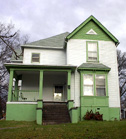|

201 E. Oklahoma Ave.
2,200 sq. ft.
two 3bdrm/1bath units
$59,900
Contact: Patrick Michael
Wood Realtors: 577-7575
Click for tax credit info
Comment
on this story
|
 |

by Matt Edens
"Investor."
Live in the center-city like I do, and you cringe at the word. Often it's used as a euphemism for "slumlord"—even though actual investing is something most slumlords go out of their way to avoid. Deferred maintenance, cheap and shoddy repairs—that's how they make their money. Slumlords take a fixed asset—an old house or an apartment building—and slowly liquidate it over time. Which means declining property values and decreased property tax receipts for the city.
Reversing that slide is one of the big redevelopment challenges facing the city. Sure big corporate tenants downtown and more loft conversions are important. But unless the city can also attract a new sort of "investor" to the center city neighborhoods that ring it, downtown will remain an isolated success.
So how can the city, as cash strapped as it is, afford to offer incentives for high quality investment in center city neighborhoods—particularly when larger redevelopment projects like a downtown cinema, transit center and, possibly, a new convention center hotel are already vying for scant resources?
Federal Historic Preservation Tax Credits, that's how. A federal program that allows developers to shave as much as 20 percent off their renovation costs, the credits are essentially free as far as the city is concerned. The program is already an integral component of the city's downtown redevelopment strategy, reaping big rewards and providing a vital assist to projects like the Sterchi Building or the Tennessee Theatre restoration. And, with a small city investment in promotion and technical assistance, tax credits can generate the same return in the community development arena, assisting with smaller projects like, say, this duplex on Oklahoma Avenue in Old North Knoxville.
Other than a clawfoot tub and, amazingly, a built-in china cabinet, the interior of this house was stripped out long ago. Staircase, fireplace mantles, door and window casings, even the baseboards are all gone. Which means restoring this house to its full Victorian splendor would be quite a big project. The tax credits, however, provide the option to fully restore the exterior—which has some nice details like fish scale shingles in the front gable and a front bay window with beadboard panels and Eastlake brackets—while rehabbing the interior as an attractive up and down duplex—a move that'll stabilize the house and add an attractive asset to the neighborhood.
It'll also be an attractive investment. Say you pick this house up for $50K and spend another $100K or so on the rehab (trust me, you could). Well, you'll get $20,000 of that investment back via the tax credits (in the first year, if you owe Uncle Sam that much. Or spread out over up to five years if you don't). Lease the place for at least five years (required by the tax credits) and then you'll only have $130K in the property. A property that—even if you put the staircase back in and convert the upstairs kitchen into a master bath and sell it as a single family—will likely fetch a good bit more on the market.
And nobody'll ever be able to call you a slumlord.

January 29, 2003 * Vol. 14, No. 5
© 2004 Metro Pulse
|





